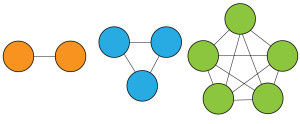In last week’s question, we chatted about clinical guidelines and algorithms. In this week’s question, we’ll be heading in a completely different direction – telecommunication and Metcalfe’s Law.
Telecommunication is communication across a distance using technology – usually via electrical signals or electromagnetic waves. Telecommunications allows us to participate in our favorite lazy leisure activities such as watching tv, browsing the internet, or talking on the phone.
To be functional, a telecommunications network typically has the following components:
- A transmitter
- A transition medium
- A receiver
- An analog or digital network
- Channels that allow for simultaneous information streams
- Switches for connections between users
- Repeaters to combat attenuation
- Modulators to shape signals for various frequencies
While we may place a “high” value our WiFi connection that allows us to search recipes on Google or watch the latest episode of Game of Thrones, there is an actual quantitative value we can assign to these networks. This theory – brought to us by Ethernet co-inventor Robert Metcalfe – is appropriately named Metcalfe’s Law.
Metcalfe’s Law describes the value of a telecommunications network depending on how many nodes there are in the network. Some may choose to call it more of a “rule of thumb” than a law, but either way, it gives a good indication of how strong a network is. A network’s value can be calculated from a very simple formula. But since that would give away the answer to the question, we’re not going to give it to you until after the question. So let’s get into it so we can get to the explanation.
Question
A network with 100 users connected would have a “value” of:
A. 10
B. 100
C. 1,000
D. 10,000
Answer and Explanation
Metcalfe’s law states that the value of a telecommunications network is proportional to the square of the number of nodes or users on the system. Therefore, a network with 100 users value would be proportional to 100^2, or D – 10,000 .
You can see from the image that the value of a network increases the larger it gets. Two nodes can along make one connection. Three nodes can make three connections, five nodes can make ten connections, and so on and so forth.
Here – a key word is “can”. Metcalfe’s law measures the number of potential connections in a network. Other applications of the law – such as the application to social utilities and networks such as Facebook, twitter, linkedin, etc., depend on the number of nodes in contact with one another.
Further Studying
If you’re looking for more resource on clinical informatics, you can purchase our text – Clinical Informatics Board Review: Pass the Exam the First Time. It’s the only board review book for the clinical informatics exam and comes with a money back guarantee if you don’t pass the exam on your first attempt – it’s the only study material for the clinical informatics exam with one.
You can also sign up for practice questions through learn.informaticspro.com if you’re looking to test your readiness for the exam. A full-length practice exam should be coming in the next couple of weeks.
References and Recommended Reading
Information Rules: A Strategic Guide to the Network Economy By Carl Shapiro, Hal R. Varian.
Metcalfe’s Law. Wikipedia.

